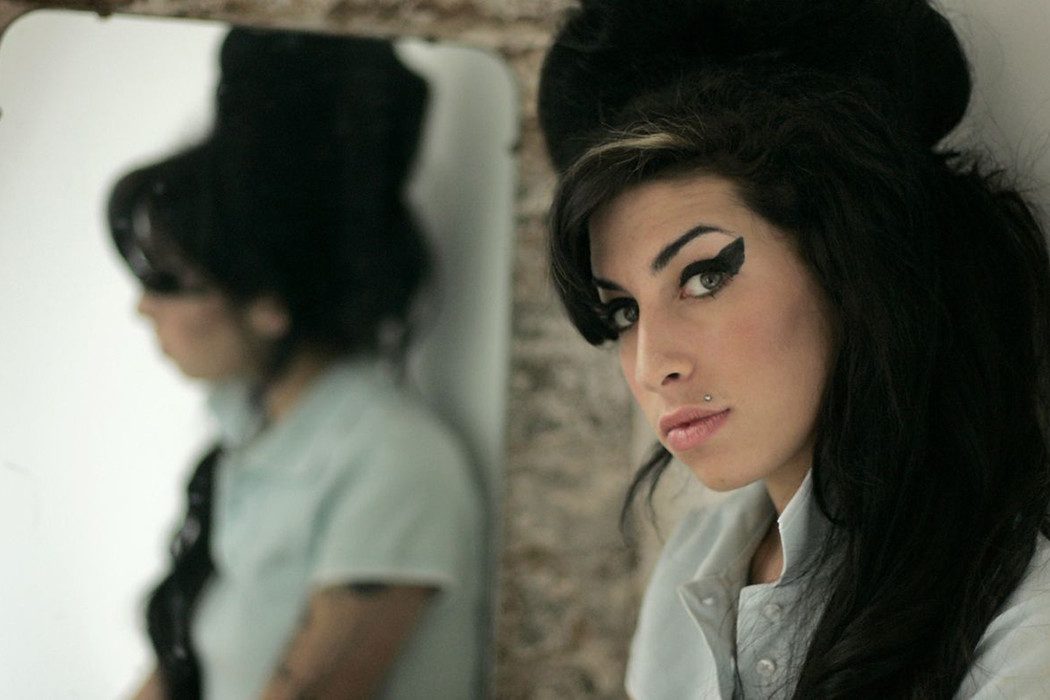Asif Kapadia’s BAFTA-winning documentary on Amy Winehouse is an incisive examination of a tragic figure, writes Rohit Chakraborty.
On a midsummer morning in 2011, when I was fifteen, two national newspapers carried, on their front pages, full-length images of a woman with a matchstick build, dressed in a sleeveless frock. Her left arm was vigorously tattooed, out of which I could make out a horseshoe thingamajig and a nude woman. Her beehive, with a white blonde streak, was far too large to balance between her shoulders. I mistook a piercing above her upper lip for a mole. She had a large bow in her hair à la Minnie Mouse. The newspapers told me that her name was Amy Winehouse and she had passed away due to alcohol poisoning.
Four years on, the tunnels of the London Underground are plastered with posters of her fierce Cleopatra-winged eyeliner that skirts her olive green eyes stamped with her first name in pink. “Each a glimpse and gone forever”, as Robert Louis Stevenson writes, is exactly what I thought with an eye-roll as the posters swept past me—another exploitative whisper of a documentary, perhaps, riddled with a clumsy arrangement of videos and photographs, and a smidgen of the influence of Mitch Winehouse, the opportunistic father that he has proven himself to be time and again.
Six months after the release of Amy, I was still uncertain about the documentary. I never had access to the broadcast of her downfall and at eleven it is hardly appropriate to learn about “blow” and “puff”, when Disney Channel is the acceptable staple. I cannot speak for those who have witnessed the celebration and degradation of Winehouse chronologically, and if Amy was an exercise in revision for them. Winehouse was instantaneously mythified for people like yours truly who were acquainted with her through death: those headlines on 23 July 2011 were our first foray into the slow death of Winehouse.
“Each a glimpse and gone forever”, as Robert Louis Stevenson writes, is exactly what I thought with an eye-roll as the posters swept past me—another exploitative whisper of a documentary, perhaps, riddled with a clumsy arrangement of videos and photographs.
The opening of Amy is a rendition of ‘Moon River’ performed as a part of the National Youth Jazz Orchestra, followed by a 1998 home video in which a Marilyn Monroe enactment of ‘Happy Birthday’ cements the 14-year-old chanteuse’s vocality: the precocious vibrato, the dips in and out of head notes and falsetto, and that alto that is ripe and ready to be exploited. Asif Kapadia does not break any new technological ground with Amy, and the story of the fatal blow to Winehouse is also stuff of urban mythologies. However, Kapadia is adept at re-accessing and re-arranging archival footage that has been at our disposal—her first audition at Island Records in 2002, television performances, disagreements with the paparazzi—and convincing us that although the life of Amy Winehouse has inadvertently become a public service announcement (the public being musicians or artistes who cannot and do not make informed choices), we are obviously intruding upon that precarious life of hers.
This awareness churns in our depths and brings about a crushing guilt when the Grammy-winning singer is seen in another home video as a wilful fledgling throwing a tantrum as Janis Winehouse struggles to keep her daughter calm. The interweaving of such unseen private footage and voice messages breached and exhibited for global consumption demystifies Winehouse. The unfaithfulness of the fleeting father, whose approval and love she constantly sought, and the mother who lacked an iron hand, is so operatic in theory that it might result in the degeneration of this documentary to fictive narration.
But for the participation of Mitch Winehouse, a suspicious businessman, testimony from Amy’s mother, like those of her friends and her former manager, Nick Shymansky, renders the documentary heart, and introspection. The waver in the narration, the crack of the voice whilst a confession is made, rips apart the shackles of the camera—the faces of these utterances never appear before us—and the stoicism imposed by the framework of journalistic cinema. It is the existence of such quiet emotional embellishments that humanise the Winehouse who has been cast in print and through the lens as the damaged woman-child with a prized possession that has manufactured two albums and brought felicitations aplenty, if only they could have bought domestic felicity as well.
For all that, though, Amy is hardly a romantic project and it would be lazy to call it a cinematic post-mortem. It is acceptably balanced, if not desirably so: Blake Fielder-Civil, Winehouse’s husband, cause of her anguish, her partner in crack cocaine, is cut off mid-testimony, it seems, when the narration zeroes in on the event of their divorce; Kapadia could just as well be a bitter Winehouse family member upset at the influence Fielder-Civil exercised on her who decided to obliterate the opportunity for him to purge himself, not that any such opportunity would have presented itself anyway. The quick procession of boyfriends whose names one cannot commit to memory serves the purpose of Fielder-Civil’s prime influence that rocks her.
The documentary is no tribute to its eponymous subject, either. Despite the rickety foundation of domestic life, Winehouse often demonstrated poor judgement and the film does not shy away from laying her indiscretions bare, quite literally so, by laying a montage of smudged make-up, mangled wrists and toes, slurred speech, facial blemishes caused by the drugs, et cetera. The confession of her desire to move out of her parents’ home—to seek the freedom to smoke weed—is simultaneously naïve and profound.
The sections that exhibit her performances highlight exactly what drew listeners to Winehouse early in her career: her delivery was as unpredictable as her behaviour—often improvised, a bona fide jazz artist like Ella Fitzgerald (who gabbed hilarious nonsense in one performance of ‘Summertime’), employing variations that sometimes kept the audience on the balls of their feet, waiting for the voice to crack or meander off-key, which it seldom did. Her studio sessions, ‘Back to Black’ with Mark Ronson in particular, discounts the pop fascination with lyrical dissociation through manufactured conformity. The section of the song where Winehouse sings the singular word “Black” multiple times into the microphone before launching into the chorus draws out a reaction from the singer herself as she exclaims to Ronson how melancholic it makes her.
The sections that exhibit her performances highlight exactly what drew listeners to Winehouse early in her career: her delivery was as unpredictable as her behaviour—often improvised, a bona fide jazz artist like Ella Fitzgerald, employing variations that sometimes kept the audience on the balls of their feet, waiting for the voice to crack or meander off-key, which it seldom did.
Kapadia allows the camera traversal through Winehouse’s notebooks—that is where the poet resides. The neat, confident hand of Amy conveys lyrics that are superficially simple but unravel to reveal a conquest, a conquest to make amends, make sense, or make do with her past and present. The effect of lifting the words off her notebooks and displaying them like a karaoke arrangement to accompany her live performances is where one will truly find oneself sympathising with the singer, having shed the lens of the psychoanalyst and the binoculars of the comedian.
Speaking of the binoculars of the comedian, it is disheartening to see Graham Norton, and Jay Leno, who invited Winehouse to perform ‘Rehab’ on The Tonight Show in 2007, ridicule her with much applause from the studio audience. This perfectly captures the Jeanne d’Arc treatment meted out to the troubled celebrities of our pop culture—as long as nothing as serious as death befalls them due to their habits, they are in a cage, with fingers pointed at them, raucous laughter ringing round. Once they perish, the bars of this cage dissolve and only a pedestal remains that elevates them higher to the heavens where light of their glory days eradicates their troubled past. Ironically, in their final days, it is this light that is absent and their melodies are overshadowed by their wails.
Upon watching Amy, one will be assured that Winehouse was not one to revel in celebrity acquired; on the contrary, she writhed in it. The added pleasures of adoration, a by-product of celebrity, were what she enjoyed, for they brought Tony Bennett knocking on her door, resulting in ‘Body and Soul’. Bennett was to Winehouse what Etta James was to Adele and Ray Charles to Norah Jones. The childlike fumbling in the studio, a wilfulness to please an idol standing a few inches from her, harks back to her pursuit of a father’s affection.
It is disheartening to see Graham Norton, and Jay Leno, who invited Winehouse to perform ‘Rehab’ on The Tonight Show in 2007, ridicule her with much applause from the studio audience. This perfectly captures the Jeanne d’Arc treatment meted out to the troubled celebrities of our pop culture—as long as nothing as serious as death befalls them due to their habits, they are in a cage, with fingers pointed at them, raucous laughter ringing round.
Before footage of her death is presented, a few paparazzi shots of Winehouse show her to be slightly puffy, almost healthy, on the brink of reclaiming life—the final vigour of the flame before the light dies out. Apologies to her friends in her final hours reaffirm that unlike Cobain, Winehouse intended to stick around longer than she wanted. If only the documentary could have cited her fear of joining the 27 Club (“holy men at their death have good inspirations”, indeed), the horror of her death might have been augmented for in the citation of such a fear is the crux of her entire struggle: “They tried to make me go to rehab/But I said, ‘No, no, no!’”
For a Reverse Fan like myself, Amy was revelational in parts, inadequate in others. However, quite possibly, Kapadia’s record of Winehouse decomposition will be glorified in the years to come, because it is unapologetically incisive and occasionally discomfiting. Kapadia has affirmed the withholding of much material while making this documentary. This distillation is welcome news or dreaded shame, depending on how poor you are in separating subject from art form. Kapadia is neither just a foul-crier nor just a sycophant. He is neither just a journalist nor just a mourner. He is all and none at different times, and that makes Amy a thrill to watch.














